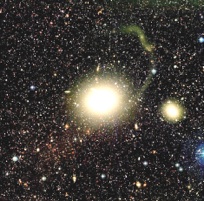
Stellar streams
In the context of the MATLAS project, stellar streams refer to the tidal tails that emanate from disrupted satellite galaxies. Until it is totally disrupted, two tails are formed on each side of the galaxy, forming a «S-shape». They wrap around the host galaxy, possibly making several loops. Being formed of material originating in dwarf galaxies, they mainly consist of old, metal-poor stars. They are usually gas-poor, like their progenitors.
Optical stellar streams in a nutshell
-
• Shape: narrow, curved, with possibly a remnant
-
• Surface brightness: fainter than 26 mag.arcsec-2
-
• Number: two for each disrupted satellite (forming a S-Shape)
-
• Color: same color as the dwarf progenitor, typically g-r = 0.8
Example of Stellar Stream candidate within the MATLAS survey
(NGVS image)
What streams tell about the mass assembly of galaxies?
Given their definition, they reveal the occurrence of minor, dry, mergers (typically 1:10). They are of low surface brightness, but compared to the broad tidal tails formed in major mergers, they seem to be longer lived. Numerical simulations (see figure to the right) predict typical life time of up to 3 Gyr (isolated)
Number of stellar streams in a simulated galaxy facing several mergers, including multiple minors one (Michel-Dansac et al., 2013)



Multiple stellar streams wrapping around a host at the end of a simulation modeling the mass assembly of a galaxy in a cosmological context (© Martig et al)